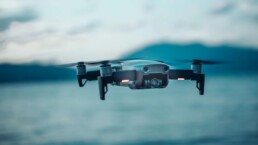As drone technology continues to push boundaries, file systems help ensure performance and data storage stay sky-high.
Tuxera was at CES 2022 last week, and some intriguing drone technology that caught our eye.
Pushing drones to new, imaginative limits
We were impressed by how much progress has been made in drones over the last few years. It’s an area of technology that has seen strong development in recent years, with the global consumer drone market expected to hit $3.26 billion in 2025, according to a report by Research And Markets.
At CES, we saw hydrogen fuel cell drones and huge piloted drones from SkyDrive, a Japanese tech startup. Their featured piloted drone was the Model SD-03, which promises to be extremely light and compact, as well as emission-free to boot. But as a VTOL (vertical take-off and land) aircraft, is it a stretch to still call it a drone?
The company Autel Robotics had quite a few drones on display, including their EVO Nano. This is a tiny model of drone, weighing in at under 250 grams and able fit into a decent-sized pocket. These small drones use a lot of modern technology, with Moore’s law being cleverly used to deliver more capable payloads in ever lighter packages. Other Autel drones on display included the Lite+ and the Dragonfish – the latter of which has a 120 minute flight time and multiple camera packages with multiple camera feeds. These advanced, high-performing cameras put a heavy demand on the file system.
We also observed underwater drones (from Chasing), drones for aerial cinematography (from Xdynamics), and even drones for Mars – NASA’s JPL Ingenuity technology demo.
HANDPICKED RELATED CONTENT
The drones of tomorrow demand crystal clear footage
Many of the cutting-edge models of drones we saw at CES made increasing use of highly advanced video cameras. With drones used in anything from aerial photography to visual safety inspections in buildings [1], maintaining high quality video camera capabilities as a major feature makes perfect sense. The EVO Nano model of drone mentioned earlier is capable of 4K footage and 48 megapixel stills on a tiny frame – no small feat.
On drones that push the limits of usability, the need for better photography and recording features means that camera capabilities are constantly scaling upwards too. Even at a fixed frame rate, a larger frame size of drone may mean a LOT more data arriving at the file system, and no extra time to deal with it. The media too must keep up, and fortunately the SD Association has delivered new media: the “V” video class cards and SD Express.
Assuming the right media is chosen, the file system has to pass any camera data onwards with minimal overhead. Too much overhead is referred to as system latency, and in the end results in lost or “dropped” frames on the video. To the drone user, the video can look choppy or stuttering – a poor user experience to say the least.
After camera data is captured by the drone, the next issue is storage. With the quality of camera data demanded by sophisticated drones, data reliability is no small concern. High-quality recording devices have write-heavy workloads, and flash devices in general have a limited number of write cycles. What’s more, highly mobile devices like drones can very realistically simply crash, potentially damaging the data.
File systems help ensure drone camera footage is smooth, and safely stored
One of the ways to help ensure high-performing cameras on drones and reliable storage is with quality-assured file systems.
Tuxera provides the best possible file system options in this case. For data stored on external media (such as a V class SD card), Microsoft exFAT by Tuxera provides the highest performance and lowest latency on a variety of operating systems used by drone and camera manufacturers.
Data stored on an internal media is not limited by the SD card speed class, but that doesn’t lessen the impact of file system latency. The Tuxera Reliance family of internal file systems deliver the strongest performance while also maximizing device lifetime.
Tuxera file systems feature proprietary methods to fight write amplification in flash storage, increasing the endurance and lifetime of the media while maintaining consistent and stable recording performance. Our software employs patented methods to protect user data retention and volume integrity, prevent or reduce data loss and corruption, and offer power fail-safety.
All in all, that means the end user can experience smoother camera performance from a drone that will last longer under heavy use.
Final thoughts
CES 2022 shed light onto the direction of modern drone development, and the innovations occurring in how drones are built, as well as their envisioned uses. While sophisticated drones implement advanced cameras, the nature of drones as devices mean camera performance and data reliability on the drone are ongoing concerns.
File systems optimized for camera performance and reliability can help ensure that even the most high-tech drone achieves the camera performance and data storage that it deserves. And that’s a level of end user satisfaction we have a deep understanding of.
References:
[1] https://www.flyability.com/drone-inspections
*Photo by https://unsplash.com/@jeisblack.
Learn more about how our file systems help deliver high-quality storage performance and reliability in the consumer space.


